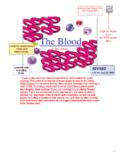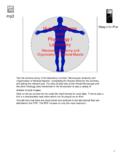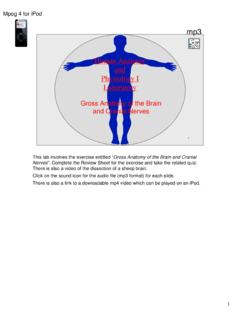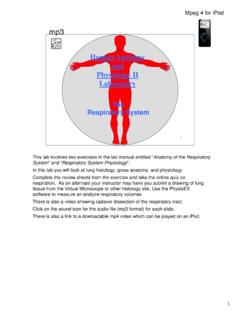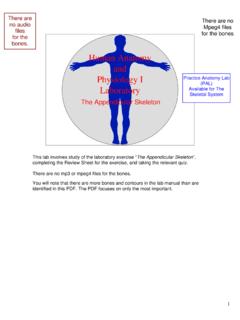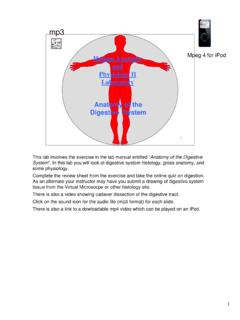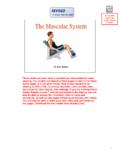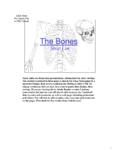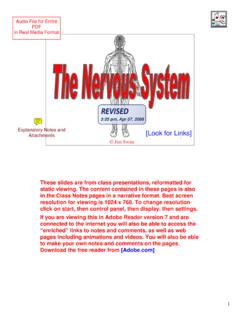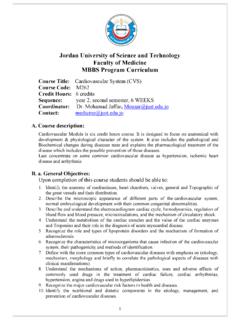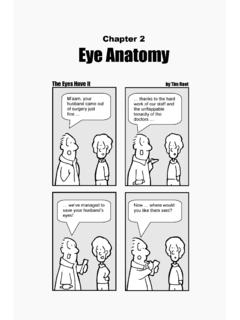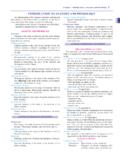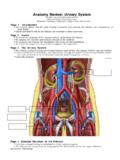Transcription of © Jim Swan - Class Videos
1 11 Jim SwanThese slides are from Class presentations, reformatted for static viewing. The content contained in these pages is also in the Class Notes pages in a narrative format. Best screen resolution for viewing is 1024 x 768. To change resolution click on start, thencontrol panel, then display, then settings. If you are viewing this in Adobe Reader version 7 and are connected to the internet you will also be able to access the enriched links to notes and comments, as well as web pages including animations and Videos . You will also be able to make your own notes and comments on the pages.
2 Download the free reader from [ ]33 Two Circulatory DivisionsPulmonary Division: lung capillaries where blood is oxygenated from Division: lung capillaries where blood is oxygenated from bloodOxygenated bloodSystemic Division: all tissues and organs which receive oxygenated Division: all tissues and organs which receive oxygenated arteryPulmonary veinsAorta Vena cavaeThere are two divisions in the circulatory system: The Pulmonary Division- Lung capillaries serving structures where oxygen is obtained and carbon dioxide removed via respiration and not via the blood supply.
3 The Systemic Division- All other organs and tissues where oxygen is provided by oxygenated blood in incoming arteries and carbon dioxide is carried away by outgoing veins. The heart is really two pumps: the right heart pumps de-oxygenated blood received from the systemic division to the lungs to become oxygenated, and the left heart pumps this oxygenated blood to the systemic division to deliver oxygen to the tissues and pick up carbon dioxide. 444 Diagramatic View of Right HeartSup. Vena cavaInf. VenacavaRight atriumRight ventricleVeins return blood to the return blood to the carry blood away from the carry blood away from the to lungsPulmonary trunkPulmonary arteriesDeoxygenated bloodThe right heart is blue because it carries deoxygenated blood , receiving it from the systemic system and pumping it to the pulmonary system for Vena cavaInf.
4 VenacavaRight atriumRight ventriclePulmonary arteriesLeft ventricleLeft atriumTo systemic divisionPulmonary veinsAorta Diagramatic View of Left HeartThere are 4 (sometimes 5) pulmonary are 4 (sometimes 5) pulmonary lungsOxygenated bloodLeft heart is red because it carries and pumps oxygenated blood . blood enters from the pulmonary division and the left ventricle pumps it to the systemic division. Because the left atrium spreads behind the heart the right pulmonary veins are obscured in most anterior views (here shown by dotted lines). A pulmonary vein originates from each lobe of each lung, three on the right, two on the left, but usually two of the right pulmonary veins fuse before reaching the left Valves Produce One-way blood FlowAtrioventricular (AV) valves prevent backflow of blood into the atria when the ventricles valve between left atrium and left ventricletricuspid valve between the right atrium and right ventricleThe heart pumps by squeezing, compressing and pressurizing the blood which then flows down the pressure gradient.
5 The heart s valves force the blood to go in one direction and prevent (when workingproperly) backward ValvesVena cavaeRight atriumPulmonary veinsAorta Bicuspid valveTricuspid valveChordaetendineaePapillary muscleThe atrioventricular valves are found at the openings between each atrium and ventricle. They are held in place by chordae tendineae, which keep them from pushing inside-out. The chordae tendineaeattach to muscular extensions from the ventricular wall called papillary relaxes. AV valve flows throughvalve, filling valve closed bypressure of blood whenventricle beginscontraction, blood forcedinto of the Atrioventricular ValvesventricleValve cuspsChordaetendineaePapillary muscleFigure valves work in capturing blood as a parachute captures air.
6 As blood fills the valves they press closely against one another blocking the pathway back to the atrium. The chordae tendineae act like the parachute ropes to prevent spilling of blood , or leakage. AV closing makes a slapping sound heard as the first heart sound. (the lubb in lubb-dubb )99 Semilunar Valves prevent backflow of blood into the ventricles when the ventricles valve at entrance to aortapulmonary valve at entrance to pulmonary trunkThe semilunar valves also have cusps, which catch blood as it flows back toward the ventricle during ventricular ValvesVena cavaeRight atriumPulmonary veinsAorta Pulmonary valveAortic valveLocation of the semilunar valves is at the entrance to both arteries, the pulmonary and of the Semilunar Valvesventriclevalve cuspventricleVentricle contracting, valve open, blood flows into relaxes.
7 Backflow of blood closes produces the second heart produces the second heart valves contain three cusps each. When the ventricles contract these valves open as blood rushes through, and the cusps are pushed back against the arterial wall. When the ventricles relax blood is pulled back toward the ventricles, filling the cusps, and closing the semilunar are shown from above. Note the origin of the coronary arteries behind the aortic semilunar valves. Also note the anastomosis between them which produces collateral circulation. Slight gaps can allow small amounts of blood to leak through, creating sound known as a heart murmur.
8 Most murmurs are insignificant, but if the leakage is significant blood flow will be impaired and heart valve replacement will be ValveValve cuspsPapillary muscleChordae tendineaeHere you see the cusps of the bicuspid (mitral) valve with their chordaetendineae and attach papillary Aortic Semilunar ValveOpening into the coronary arteries lie behind the valve cuspsBehind two of the semilunar valve cusps are the openings into the coronary arteries. These arteries will, therefore, fill when ventricular diastole fills the :stenosis- constriction and narrowing of a valve, usually caused by disease.
9 Prolapse- a stretched valve resulting in incomplete closure and producing leakage. heart murmur- the sound produced by a leaking valve. Most murmurs are inconsequential but some indicate severe inadequacy of the valve. regurgitation - the backflow of blood due to an incompetent (ineffective) valve. All of these conditions make valves inefficient, and can lead to cardiac congestion and ultimately heart the blood flow through the heart listing in order all vessels, chambers, and valves. Start with deoxygenated blood arriving from the systemic division, and end with oxygenated blood entering the systemic 15 will go over the flow in the next is a study assignment which will help you to conceptualize blood flow through the heart.
10 Specify at each point whether the blood is oxygenated or deoxygenated. 17171) Deoxygenated blood from systemic division222) Superior and inferior vena cavae33) Right atrium44) Tricuspid valve55) Right ventricle66) Pulmonary valve77) Pulmonary arteries8) Lungs1010) Left atrium1111) Bicuspid valve1212) Left ventricle13) Aortic valve1414) Aorta Figure e15) Oxygenated blood to systemic division99) Pulmonary veins9 Here is the scheme for the assignment from the previous slide. If you did it yourself, excellent. If you didn t, then just do Section of Heartr. auricleTricuspid muscleRVPulmonary trunkSup.
